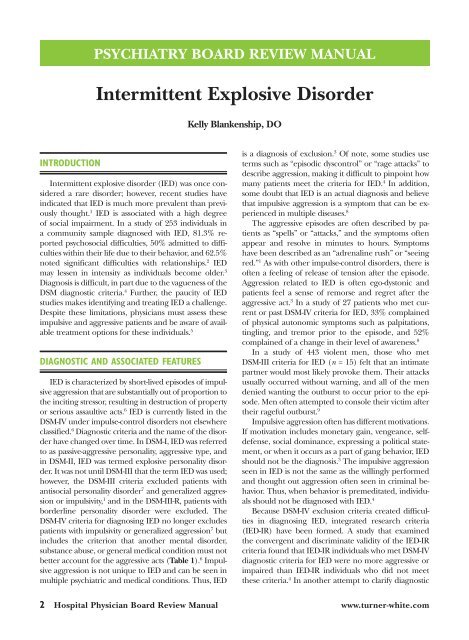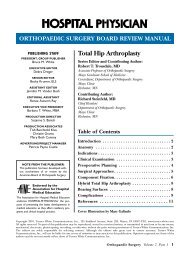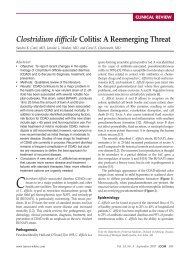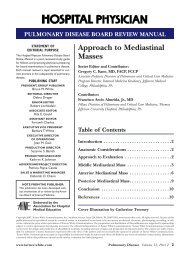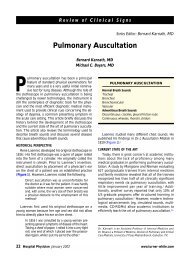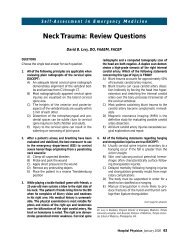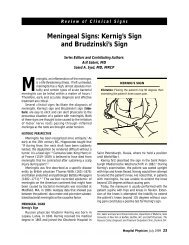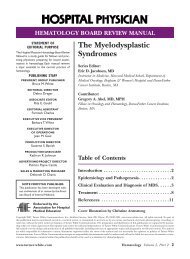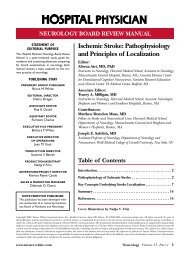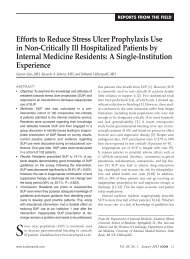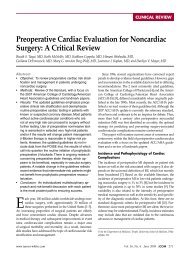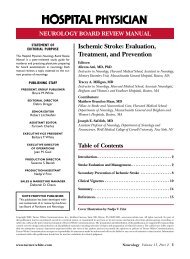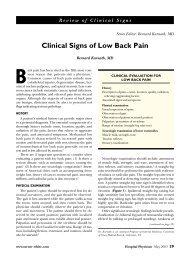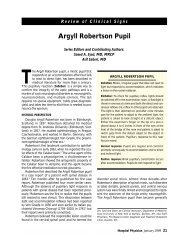Intermittent Explosive Disorder - Turner White
Intermittent Explosive Disorder - Turner White
Intermittent Explosive Disorder - Turner White
Create successful ePaper yourself
Turn your PDF publications into a flip-book with our unique Google optimized e-Paper software.
Psychiatry Board Review Manual<br />
<strong>Intermittent</strong> <strong>Explosive</strong> <strong>Disorder</strong><br />
Kelly Blankenship, DO<br />
INTRODUCTION<br />
<strong>Intermittent</strong> explosive disorder (IED) was once considered<br />
a rare disorder; however, recent studies have<br />
indicated that IED is much more prevalent than previously<br />
thought. 1 IED is associated with a high degree<br />
of social impairment. In a study of 253 individuals in<br />
a community sample diagnosed with IED, 81.3% reported<br />
psychosocial difficulties, 50% admitted to difficulties<br />
within their life due to their behavior, and 62.5%<br />
noted significant difficulties with relationships. 2 IED<br />
may lessen in intensity as individuals become older. 3<br />
Diagnosis is difficult, in part due to the vagueness of the<br />
DSM diagnostic criteria. 4 Further, the paucity of IED<br />
studies makes identifying and treating IED a challenge.<br />
Despite these limitations, physicians must assess these<br />
impulsive and aggressive patients and be aware of available<br />
treatment options for these individuals. 5<br />
DIAGNOSTIC AND ASSOCIATED FEATURES<br />
IED is characterized by short-lived episodes of impulsive<br />
aggression that are substantially out of proportion to<br />
the inciting stressor, resulting in destruction of property<br />
or serious assaultive acts. 6 IED is currently listed in the<br />
DSM-IV under impulse-control disorders not elsewhere<br />
classified. 6 Diagnostic criteria and the name of the disorder<br />
have changed over time. In DSM-I, IED was referred<br />
to as passive-aggressive personality, aggressive type, and<br />
in DSM-II, IED was termed explosive personality disorder.<br />
It was not until DSM-III that the term IED was used;<br />
however, the DSM-III criteria excluded patients with<br />
antisocial personality disorder 7 and generalized aggression<br />
or impulsivity, 1 and in the DSM-III-R, patients with<br />
borderline personality disorder were excluded. The<br />
DSM-IV criteria for diagnosing IED no longer excludes<br />
patients with impulsivity or generalized aggression 7 but<br />
includes the criterion that another mental disorder,<br />
substance abuse, or general medical condition must not<br />
better account for the aggressive acts (Table 1). 6 Impulsive<br />
aggression is not unique to IED and can be seen in<br />
multiple psychiatric and medical conditions. Thus, IED<br />
Hospital Physician Board Review Manual<br />
is a diagnosis of exclusion. 3 Of note, some studies use<br />
terms such as “episodic dyscontrol” or “rage attacks” to<br />
describe aggression, making it difficult to pinpoint how<br />
many patients meet the criteria for IED. 4 In addition,<br />
some doubt that IED is an actual diagnosis and believe<br />
that impulsive aggression is a symptom that can be experienced<br />
in multiple diseases. 8<br />
The aggressive episodes are often described by patients<br />
as “spells” or “attacks,” and the symptoms often<br />
appear and resolve in minutes to hours. Symptoms<br />
have been described as an “adrenaline rush” or “seeing<br />
red.” 1 As with other impulse-control disorders, there is<br />
often a feeling of release of tension after the episode.<br />
Aggression related to IED is often ego-dystonic and<br />
patients feel a sense of remorse and regret after the<br />
aggressive act. 3 In a study of 27 patients who met current<br />
or past DSM-IV criteria for IED, 33% complained<br />
of physical autonomic symptoms such as palpitations,<br />
tingling, and tremor prior to the episode, and 52%<br />
complained of a change in their level of awareness. 8<br />
In a study of 443 violent men, those who met<br />
DSM-III criteria for IED (n = 15) felt that an intimate<br />
partner would most likely provoke them. Their attacks<br />
usually occurred without warning, and all of the men<br />
denied wanting the outburst to occur prior to the episode.<br />
Men often attempted to console their victim after<br />
their rageful outburst. 9<br />
Impulsive aggression often has different motivations.<br />
If motivation includes monetary gain, vengeance, selfdefense,<br />
social dominance, expressing a political statement,<br />
or when it occurs as a part of gang behavior, IED<br />
should not be the diagnosis. 3 The impulsive aggression<br />
seen in IED is not the same as the willingly performed<br />
and thought out aggression often seen in criminal behavior.<br />
Thus, when behavior is premeditated, individuals<br />
should not be diagnosed with IED. 4<br />
Because DSM-IV exclusion criteria created difficulties<br />
in diagnosing IED, integrated research criteria<br />
(IED-IR) have been formed. A study that examined<br />
the convergent and discriminate validity of the IED-IR<br />
criteria found that IED-IR individuals who met DSM-IV<br />
diagnostic criteria for IED were no more aggressive or<br />
impaired than IED-IR individuals who did not meet<br />
these criteria. 4 In another attempt to clarify diagnostic<br />
www.turner-white.com


